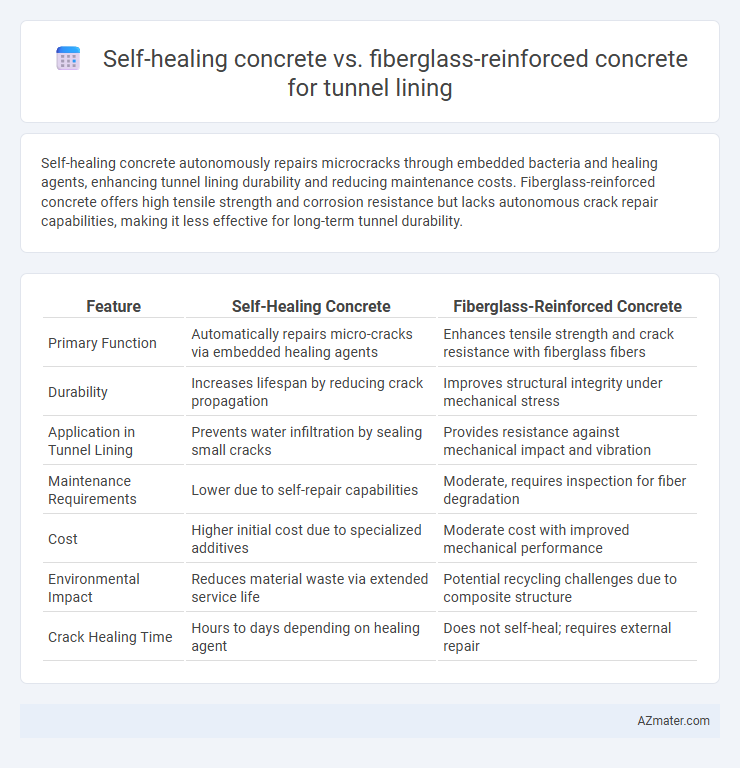Self-healing concrete autonomously repairs microcracks through embedded bacteria and healing agents, enhancing tunnel lining durability and reducing maintenance costs. Fiberglass-reinforced concrete offers high tensile strength and corrosion resistance but lacks autonomous crack repair capabilities, making it less effective for long-term tunnel durability.
Table of Comparison
| Feature | Self-Healing Concrete | Fiberglass-Reinforced Concrete |
|---|---|---|
| Primary Function | Automatically repairs micro-cracks via embedded healing agents | Enhances tensile strength and crack resistance with fiberglass fibers |
| Durability | Increases lifespan by reducing crack propagation | Improves structural integrity under mechanical stress |
| Application in Tunnel Lining | Prevents water infiltration by sealing small cracks | Provides resistance against mechanical impact and vibration |
| Maintenance Requirements | Lower due to self-repair capabilities | Moderate, requires inspection for fiber degradation |
| Cost | Higher initial cost due to specialized additives | Moderate cost with improved mechanical performance |
| Environmental Impact | Reduces material waste via extended service life | Potential recycling challenges due to composite structure |
| Crack Healing Time | Hours to days depending on healing agent | Does not self-heal; requires external repair |
Introduction to Tunnel Lining Materials
Self-healing concrete for tunnel lining incorporates microcapsules or bacteria that autonomously repair cracks, enhancing durability and reducing maintenance costs. Fiberglass-reinforced concrete (FRC) offers superior tensile strength and crack resistance due to embedded alkali-resistant glass fibers, improving overall structural integrity. Both materials address common tunnel lining challenges, but self-healing concrete emphasizes longevity through autonomous repair while FRC focuses on mechanical reinforcement and toughness.
Overview of Self-Healing Concrete
Self-healing concrete for tunnel lining incorporates bacteria or encapsulated healing agents that activate to repair micro-cracks autonomously, enhancing durability and reducing maintenance costs. This innovative material minimizes water ingress and structural degradation, addressing common challenges faced by conventional concrete in tunnels. In contrast, fiberglass-reinforced concrete primarily improves tensile strength and crack resistance but lacks autonomous repair capabilities.
Fundamentals of Fiberglass-Reinforced Concrete
Fiberglass-reinforced concrete (FRC) in tunnel lining integrates alkali-resistant glass fibers into the concrete matrix, enhancing tensile strength and crack resistance compared to traditional concrete. The fibers distribute stresses more evenly, improving durability and reducing maintenance needs, essential in harsh underground environments. Unlike self-healing concrete, which autonomously repairs microcracks through embedded healing agents, FRC relies on fiber reinforcement to prevent crack formation and propagation, providing structural integrity over time.
Mechanical Strength Comparison
Self-healing concrete exhibits superior mechanical strength in tunnel lining applications due to its ability to autonomously repair microcracks, enhancing durability and reducing maintenance costs over time. Fiberglass-reinforced concrete offers increased tensile strength and crack resistance through embedded glass fibers but lacks the autonomous repair mechanism inherent to self-healing concrete. Comparative studies indicate self-healing concrete maintains higher structural integrity under repeated stress, making it a preferred material for long-term tunnel durability.
Durability and Longevity
Self-healing concrete enhances tunnel lining durability by autonomously repairing micro-cracks, reducing maintenance costs and extending service life beyond 100 years. Fiberglass-reinforced concrete improves toughness and crack resistance due to its high tensile strength fibers but lacks autonomous repair capabilities, potentially requiring more frequent inspections and repairs. In terms of longevity, self-healing concrete offers superior performance in harsh tunnel environments through continuous crack sealing, whereas fiberglass-reinforced concrete relies on initial mechanical reinforcement for durability.
Crack Resistance and Repair Capabilities
Self-healing concrete incorporates microcapsules or bacteria that activate upon crack formation, sealing fissures autonomously and enhancing long-term durability in tunnel linings. Fiberglass-reinforced concrete offers improved tensile strength and crack resistance by distributing stress more evenly but requires external intervention for crack repair. The self-healing properties minimize maintenance costs and downtime, whereas fiberglass-reinforced concrete relies on its mechanical reinforcement to delay crack propagation without enabling autonomous repair.
Environmental Impact and Sustainability
Self-healing concrete for tunnel lining reduces maintenance frequency and extends structural lifespan by autonomously repairing cracks, lowering material consumption and environmental footprint compared to traditional materials. Fiberglass-reinforced concrete enhances durability and corrosion resistance but involves energy-intensive fiber production and potential recyclability challenges. The sustainability advantage of self-healing concrete lies in its ability to minimize resource use and carbon emissions throughout the tunnel lifecycle, promoting greener infrastructure solutions.
Cost Analysis and Lifecycle Economics
Self-healing concrete for tunnel lining reduces long-term maintenance costs by autonomously repairing cracks, enhancing durability and extending service life, which offsets its higher initial material costs compared to fiberglass-reinforced concrete (FRC). Fiberglass-reinforced concrete offers a lower upfront expenditure with improved tensile strength and corrosion resistance, but it may require more frequent repairs and maintenance due to limited crack self-repair capabilities. Lifecycle economic analysis indicates that while FRC is cost-effective initially, self-healing concrete delivers superior value over the tunnel's lifespan by minimizing repair frequency and associated downtime expenses.
Installation and Maintenance Requirements
Self-healing concrete for tunnel lining reduces maintenance frequency by automatically sealing microcracks, minimizing water ingress and structural damage over time, which significantly lowers long-term repair costs. Fiberglass-reinforced concrete offers enhanced tensile strength and crack resistance but requires regular inspections and maintenance to address potential fiberglass corrosion and ensure structural integrity. Installation of self-healing concrete involves advanced mixing techniques and integration of healing agents, while fiberglass-reinforced concrete demands careful handling and precise placement to maintain fiber alignment for optimal reinforcement.
Best Use Cases and Applications in Tunnel Construction
Self-healing concrete is ideal for tunnel lining in environments prone to micro-cracking and water ingress, as its embedded healing agents autonomously repair cracks, enhancing durability and reducing maintenance. Fiberglass-reinforced concrete excels in applications requiring high tensile strength and corrosion resistance, especially in tunnels exposed to aggressive chemical conditions or seismic activity. Combining both materials can optimize tunnel lining performance by leveraging self-healing properties for longevity and fiberglass reinforcement for structural resilience.

Infographic: Self-healing concrete vs Fiberglass-reinforced concrete for Tunnel lining
 azmater.com
azmater.com